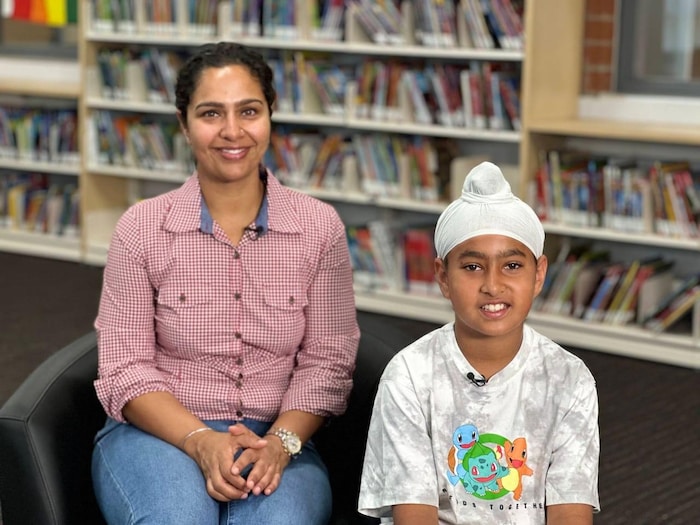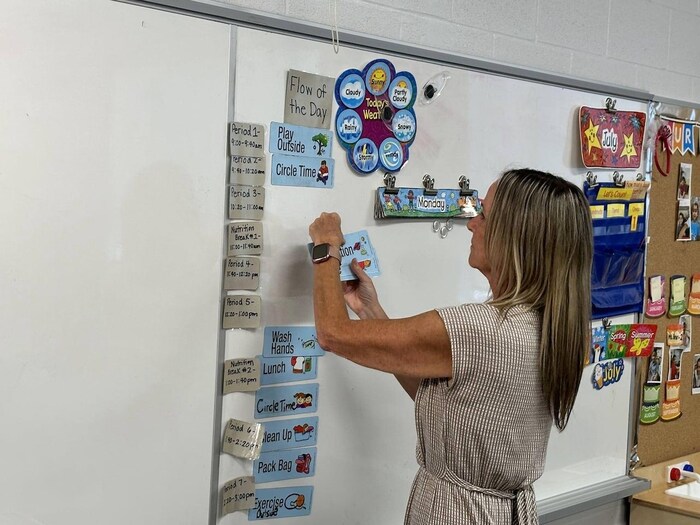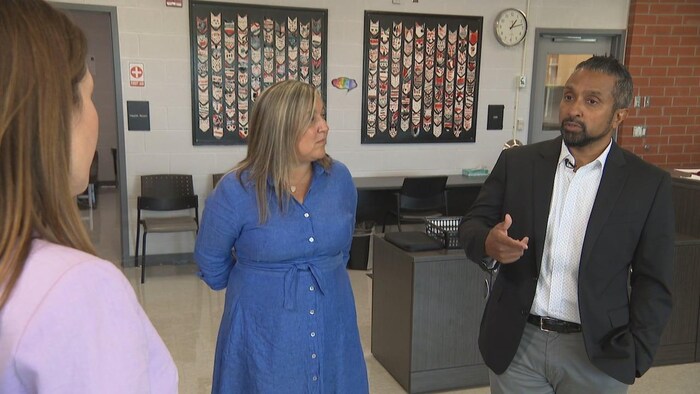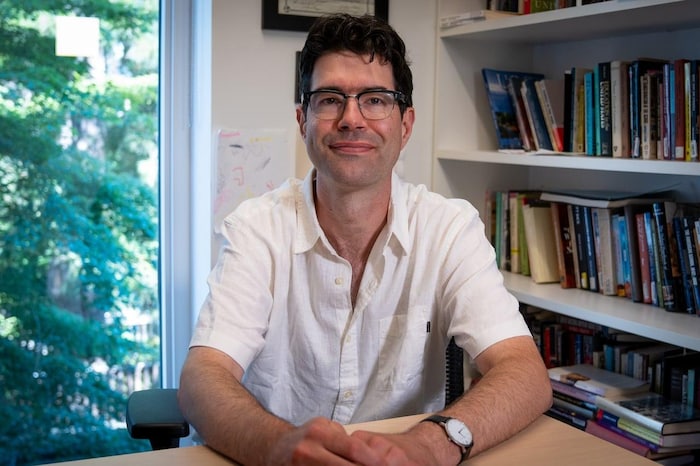Canada News
Some kids are back in class already. Why aren’t more schools open year-round?
By Jessica Wong, CBC News, RCI
Issues with infrastructure, co-ordination prevent more from having year-round school

Roberto Sarjoo is a fan of the balanced calendar schedule school in Caledon, Ont., attended by his three kids (front row from left) Amiyana, Amariya and Zavier. Sarjoo feels more frequent breaks help combat burnout for students, while a shorter pause in the summer helps kids jump back into learning quicker. Photo: CBC / Deana Sumanac-Johnson
July just ended, but for some, school’s already back in session.
Mohan Mathews started Monday as the new principal of Tony Pontes Public School, which follows a balanced calendar model: a shorter summer break in exchange for other stretches off during the year.
Teachers, other administrators and our parent community — anyone I’ve run into who have had any kind of experience with a balanced-year calendar school — have absolutely loved it,
Mathews said at the Caledon, Ont., school.
Just when students [and] teachers would benefit from a break, the balanced year school model lends itself to that.
Sikander Sidhu, who’s attended Tony Pontes P.S. since kindergarten, is also a fan of this schedule.

The year-round schedule at Sikander Sidhu’s school has allowed his family to enjoy longer breaks together at different times of year, says his mom Jasmine Gill (at left).
Photo: CBC / Prisca Tang
Instead of having a long summer break and getting bored, you can you spread them out through the entire year,
said the Gr. 5 student. It’s fun having breaks when some other kids don’t.
Advocates praise the balanced calendar model as a way to stave off summer learning loss, keep minds refreshed and give families different opportunities to enjoy time off. Yet infrastructure concerns, co-ordination challenges and a spotty track record in the U.S. are among the barriers to more schools adopting a year-round schedule.
Carrying the same total instructional days as regular schools, balanced calendar schools distribute breaks differently. Peel’s balanced schools, for instance, start about a month earlier. They take two weeks off at Thanksgiving, three weeks in December, a week before Family Day and March break is doubled.

Comparing Peel’s 2024-2025 school calendar
Photo: CBC
That breakdown can look different elsewhere: some schools in the North, for instance, go year-round to allow students more time on the land with their families (new window).
Roberto Sarjoo says periodic breaks keep his three kids from feeling burnt out from long stretches of school, while the shorter summer break means they return without losing momentum.
They get re-engaged really quickly,
said Sarjoo, chair of the Tony Pontes P.S. parent council. Once they start back, they’re not spending time in school relearning what they may have learned at the end of the year.

Gr. 3 teacher Carol Jones prepares her classroom at Tony Pontes Public School, which started a new school year on July 29.
Photo: CBC / Prisca Tang
That’s echoed by Gr. 3 teacher Carol Jones, who has taught at Tony Pontes for five years. We can get right into the curriculum quickly. There’s not as much review that has to happen,
she said.
Having breaks more spaced out provides flexibility for families, according to Jasmine Gill, Gr. 5 student Sikander’s mom. Because her job restricts when she can take time off, this format means they’ve enjoyed longer travel at different times of year.
In December, generally we travel to India to [visit] the grandparents, so we have a good stretch of three weeks that we spend with them,
she said.
Lack of cooling, schedule conflicts
While most families in the area favour a balanced calendar, some do opt out, vice-principal Antonella Ferlisi said. Some don’t want schedule conflicts with older siblings in secondary, for example, since Peel’s high schools follow the traditional format.

‘Just when students may benefit from a break and just when teachers would benefit from a break, the balanced year school model lends itself to that,’ says Peel District School Board principal Mohan Mathews, seen at right with vice-principal Antonella Ferlisi.
Photo: CBC
Another challenge is the issue of cooling, Ferlisi said. It does cost money to run a school like this. We have to have air conditioning because we’re here in the month of August.
Many schools aren’t equipped (new window) with adequate cooling. That infrastructure issue is one of the main reasons the model hasn’t really taken off in Canada, said Jason Ellis, an associate professor of educational studies at the University of British Columbia.
Other factors include the availability of teachers willing to trade in the two-month stretch, when they typically rest, upgrade their learning (new window), work other jobs or spend time with their own kids, as well as the potential of wider ripple effects.

Lack of adequate cooling in classrooms, availability of teachers to work a modified schedule and potential ripple effects on various sectors are reasons why Canada hasn’t widely adopted year-round schooling, says Jason Ellis, an associate professor at UBC.
Photo: CBC / Dillon Hodgin
There are many businesses in British Columbia … that rely on people taking summer breaks [and attending] all sorts of summer camps,
along with those relying on high schoolers as a summer labour force, he said.
Some inaccurately blast the September to June school year as outdated, Ellis says, thinking it’s strictly based on a time when children’s help was needed on the family farm. It actually reflects more contemporary concerns, he pointed out: things like overheated and poorly ventilated buildings, as well as 20th-century surges (new window) of polio in cities in the summer.
Different ways to organize schools calendars are indeed possible, but wholesale change would need to serve … a plurality of families in the school system,
he said.
According to Ellis, the education system goes through cycles of reform, with different ideas — like year-round schooling — recurring. However, renewed discussions don’t always recall what happened the last time around.
Policymakers use a lot of history … but they don’t often study history. And so they may be unaware that 20 years ago someone tried this and it didn’t work.
‘Detrimental’ in Calif. schools, says researcher
Though relatively rare in Canada, year-round schooling is somewhat more common in the United States, where it’s been employed in a multi-track format to deal with booming student populations. This particular method staggers attendance, with students subdivided into different tracks.

Single day breaks and long weekends are not included (P.A. days, Thanksgiving etc.).
Photo: CBC
Attendance rotates so more students can attend a school. For example, school officials might split students into four tracks,
with three groups in attendance at any given time while a fourth is on break.
You’re taking that summer and you’re shortening it … but you’re creating these frequent stops and starts throughout the year. And so we found that for California, this constant stopping and starting was actually detrimental,
said Jennifer Graves, an American professor of economics at Universidad Autónoma de Madrid, who specializes in education and labour.
What is that kid doing for that … random week off in the middle of winter?
Graves has conducted large-scale studies (new window) into U.S. schools implementing balanced calendars and noted that when widely adopted in large school districts in California, including cities like Los Angeles and San Diego, it worsened academic outcomes (new window) for subgroups of traditionally disadvantaged students, including Black and Hispanic students and students of lower socioeconomic status.
In a more advantaged North Carolina district, however, a shift to year-round (new window) had a neutral learning outcome.
It doesn’t mean that there can’t be a school that’s doing this and … getting positive effects,
Graves said, but on average, we’re seeing kind of ‘best case’ being neutral, ‘worst case’ being academic harm.
Summer learning loss, which tends to more negatively impact (new window) students already struggling academically, is often cited as a main argument in favour of year-round calendars. One suggested recourse is remedial programs (new window), like summer school classes or camps, and that educational boost when a student is on break and not in school is what she thinks is key.
WATCH | How the pandemic worsened summer learning gaps:
However, a multi-track school where every classroom is being used all the time likely won’t have space to run such programming.
You really have to create that support [with supplementary programming] and probably talk to the community to find out what needs they have,
said Graves, who also found balanced calendars can negatively impact (new window)employment for women with school-aged kids.
Back in Ontario, longtime school board trustee Stan Cameron feels the balanced calendar is a success at Tony Pontes P.S., which just started its sixth year. When the school was a mere proposal for Peel District, he got a barrage of calls (new window) from interested families. PDSB already had two year-round locations (new window).
It may not work in every community, but it works in the three communities we have our schools in,
he said.
[It’s] a story about community engagement…. That’s how we got here.
With files from Deana Sumanac-Johnson, Nazima Walji and Prisca Tang
This article is republished from RCI.





















